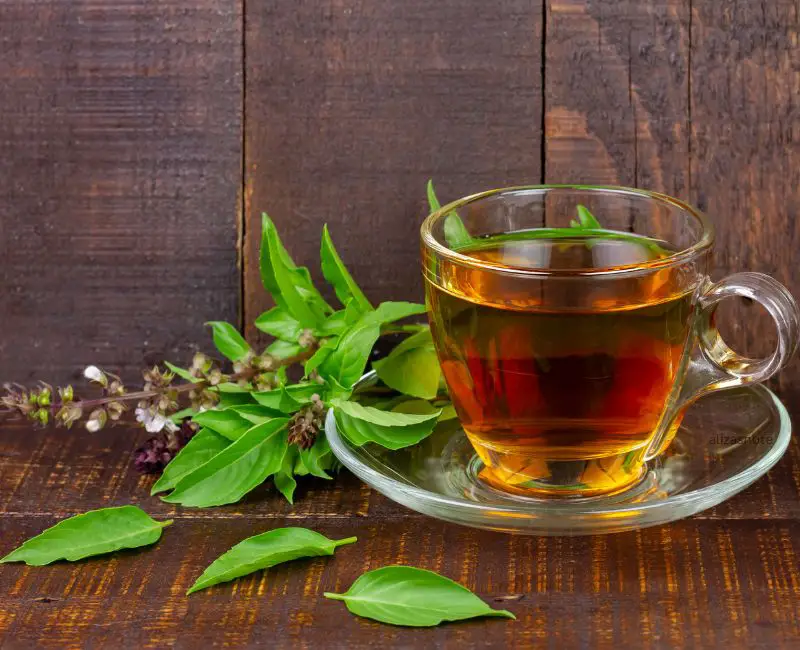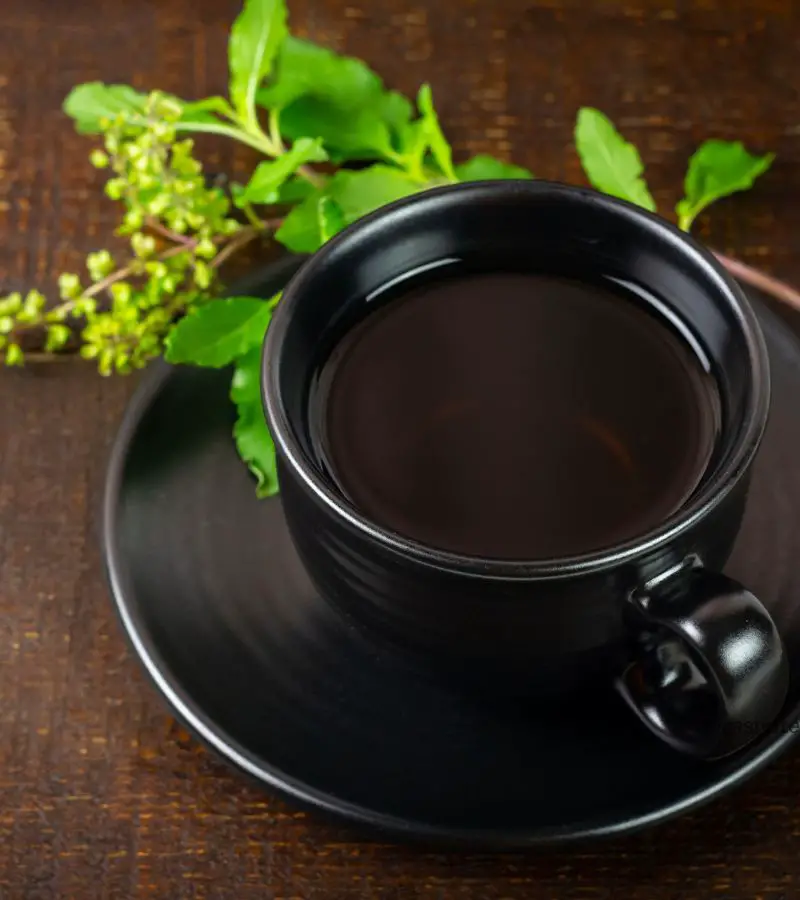Basil, renowned for its aromatic profile and culinary versatility, basil transforms effortlessly into a soothing tea, ideal for relaxation or as a natural remedy.
This delightful infusion not only offers a flavorful experience but also presents potential health benefits that make it a perfect addition to any tea lover’s repertoire.
Read below how to make basil tea from fresh leaves and benefits of basil tea and share insights on creating the perfect brew.
Benefits of Basil Tea:
Basil tea, is rich in health benefits that have been appreciated in traditional medicine for centuries. Here’s why basil tea should be part of your daily routine.
1. Rich in Antioxidants
Basil leaves are abundant in antioxidants, which help protect your body from damage caused by free radicals. These antioxidants play a crucial role in lowering the risk of chronic diseases, supporting healthy aging, and promoting overall wellness.
2. Anti-Inflammatory Properties
Basil tea contains essential oils like eugenol, citronellol, and linalool, which have potent anti-inflammatory effects. Regular consumption of basil tea can help reduce inflammation in the body, beneficial for conditions like arthritis and inflammatory bowel diseases.
3. Supports Digestive Health
Basil tea aids digestion and helps alleviate common digestive issues such as bloating, indigestion, and gas. The natural oils in basil stimulate the production of digestive enzymes, ensuring smoother digestion.
4. Boosts Immune System
Basil is rich in essential vitamins and minerals such as vitamin C, vitamin A, and iron, which are vital for maintaining a strong immune system. Drinking basil tea can strengthen your immune defenses, making you more resilient to infections and illnesses.
5. Reduces Stress and Anxiety
The adaptogenic properties of basil tea make it a fantastic natural remedy for reducing stress and anxiety. Basil helps balance stress hormones and promotes relaxation.
6. Improves Respiratory Health
Basil tea benefits respiratory health due to its antimicrobial and anti-inflammatory properties. It can help relieve symptoms of colds, coughs, and other respiratory issues by soothing the throat and reducing congestion.
7. Enhances Skin Health
The antioxidants and anti-inflammatory properties of basil also benefit your skin. Regularly drinking basil tea can improve your skin’s appearance by reducing acne, preventing premature aging, and promoting a healthy glow.
8. Regulates Blood Sugar
Studies have shown that basil can help regulate blood sugar levels, making basil tea a great addition for people with diabetes or those at risk. It improves insulin sensitivity and helps manage blood sugar spikes.
9. Promotes Heart Health
The anti-inflammatory and antioxidant properties of basil tea contribute to heart health by lowering cholesterol levels and blood pressure.
10. Natural Detoxifier
Basil tea acts as a natural detoxifier, helping cleanse the body of toxins. It supports liver function and enhances the body’s natural detoxification processes, promoting overall wellness.
Brew a cup of basil tea today and start enjoying its myriad health benefits.
How to Make Basil Tea from Fresh Leaves:
Basil tea, brewed from the aromatic leaves of the basil plant, is not only refreshing but also packed with health benefits. Here’s a detailed guide on how to make the perfect cup of basil tea from fresh leaves, along with some delicious variations.
1. Choosing the Right Basil
Types of Basil: Sweet basil is commonly used, but you can also experiment with holy basil (Tulsi), lemon basil, or Thai basil for different flavors.
Selecting Fresh Leaves: Opt for vibrant green leaves free from spots or discoloration. Freshness is crucial for a flavorful tea.
2. Harvesting Fresh Basil Leaves
When to Harvest: Pick the leaves in the morning after the dew has dried but before the sun gets too hot. This timing ensures the leaves have the most essential oils.
How to Harvest: Gently pinch off the leaves from the stem, avoiding any flowers, which can taste bitter.
3. Ingredients and Equipment Needed
- Fresh basil leaves (about 1/4 cup per cup of tea)
- Water (1 cup per serving)
- Optional add-ins: honey, lemon, ginger, mint
- Teapot or saucepan
- Strainer or tea infuser
4. Basic Basil Tea Recipe
Step 1: Rinse the Leaves
-
- Wash the fresh basil leaves under cold running water to remove any dirt or pesticides.
Step 2: Boil the Water
-
- Bring a cup of water to a boil in a teapot or saucepan.
Step 3: Prepare the Basil Leaves
-
- Slightly crush the basil leaves to release their natural oils and flavors.
Step 4: Steep the Leaves
-
- Place the basil leaves in a teapot or directly in your cup. Pour the boiling water.
Step 5: Steep Time
-
- Let the basil leaves steep for 5-10 minutes, depending on your taste preference concerning your stronger taste.
Step 6: Strain the Tea
-
- Use a strainer or tea infuser to remove the basil leaves from the tea.
Step 7: Add Optional Ingredients
-
- Add honey, lemon, or ginger to taste if desired.
Step 8: Serve and Enjoy
-
- Pour the tea into a cup and enjoy your homemade basil tea.
Variations:
Basil tea, a fragrant and flavorful drink, serves as an excellent base for creating a variety of delicious and healthful blends. Here are some exciting basil tea variations to inspire your next brew.
1. Holy Basil (Tulsi) Tea
- Ingredients: Fresh holy basil (Tulsi) leaves
- Flavor Profile: Earthy, slightly spicy, and robust
- Benefits: Tulsi, known for its adaptogenic properties, helps reduce stress and enhances overall wellness.
- Preparation: Follow the basic basil tea recipe, using holy basil leaves instead of sweet basil. This variation offers a deeper, more medicinal flavor that is both soothing and invigorating.
2. Basil and Mint Tea
- Ingredients: Fresh basil & mint leaves
- Flavor Profile: Refreshing, slightly sweet and cool.
- Benefits: Mint adds a refreshing twist, aids digestion, and provides a cooling effect.
- Preparation: Add a handful of fresh mint leaves along with the basil leaves during steeping. Find a vibrant, refreshing tea, as well as summer-friendly.
3. Basil and Lemon Tea
- Ingredients: Fresh basil leaves, a slice of fresh lemon or lemon zest
- Flavor Profile: Bright, zesty, and aromatic
- Benefits: Lemon enhances the tea’s antioxidant properties and adds a refreshing citrus tang.
- Preparation: Steep basil leaves as usual, then add a slice of fresh lemon or some lemon zest to the brewed tea. The citrusy flavor of lemon pairs beautifully with the aromatic basil, offering a revitalizing drink.
4. Basil and Ginger Tea
- Ingredients: Fresh basil leaves, slices of ginger
- Flavor Profile: Warm, spicy, and invigorating
- Benefits: Ginger provides anti-inflammatory properties, aiding digestion and soothing sore throats.
- Preparation: Add a few slices of fresh ginger to the water while it’s boiling. After boiling, steep the basil leaves in the ginger-infused water. This blend offers a warming, spicy tea perfect for chilly days or when you need a digestive boost.
5. Iced Basil Tea
- Ingredients: Fresh basil leaves, optional lemon slices, mint leaves, or berries
- Flavor Profile: Refreshing, cool, and versatile
- Benefits: A hydrating and revitalizing drink that can be customized with various fruits and herbs.
- Preparation: Follow the basic recipe, then let the tea cool to room temperature. Pour over ice and garnish with a slice of lemon, fresh mint leaves, or a handful of berries for a refreshing summer drink.
6. Basil and Honey Tea
- Ingredients: Fresh basil leaves, honey
- Flavor Profile: Sweet, aromatic, and soothing
- Benefits: Honey adds natural sweetness and boosts the tea’s soothing properties, making it ideal for calming nerves.
- Preparation: Steep the basil leaves, then stir in a teaspoon of honey. The natural sweetness of honey complements the herbaceous flavor of basil, creating a comforting tea perfect for relaxation.
7. Basil and Chamomile Tea
- Ingredients: Fresh basil leaves, dried chamomile flowers or a chamomile tea bag
- Flavor Profile: Calming, floral, and smooth
- Benefits: Chamomile provides calming properties, making this blend perfect for winding down before bed.
- Preparation: Add dried chamomile flowers or a chamomile tea bag to the basil leaves while steeping. This combination creates a soothing tea ideal for relaxing in the evening.
8. Basil and Lavender Tea
- Ingredients: Fresh basil leaves, dried lavender flowers
- Flavor Profile: Floral, aromatic, and calming
- Benefits: Lavender’s calming effects complement the stress-relieving properties of basil.
- Preparation: Add a teaspoon of dried lavender flowers to the basil leaves during steeping. This floral blend is perfect for stress relief and relaxation.
9. Basil and Cinnamon Tea
- Ingredients: Fresh basil leaves, a cinnamon stick
- Flavor Profile: Warm, spicy, and aromatic
- Benefits: Cinnamon adds a warming spice that can help regulate blood sugar levels and improve circulation.
- Preparation: Add a cinnamon stick to the boiling water before steeping the basil leaves. This blend offers a cozy, aromatic tea perfect for cooler weather.
There’s a basil tea variation for every palate and occasion. Experiment with these recipes to find your favorite combinations and enjoy the myriad benefits basil tea has to offer.
FAQs:
Q. Can you make tea with fresh basil leaves?
Yes, you can make tea with fresh basil leaves. Rinse the leaves, crush them slightly to release their oils, and steep them in hot water for 5-10 minutes.
Q. What Are the Ideal Health Benefits of Basil Tea?
Basil tea provides numerous health benefits, including antioxidant properties, anti-inflammatory effects, improved digestion, stress relief, and a boost to the immune system.
Q. Can I Use Dried Basil Leaves to Make Tea?
Yes, dried basil leaves can be used to make tea. Use about 1 teaspoon of dried basil per cup of hot water and steep for 5-10 minutes.
Q. How Often Can I Drink Basil Tea?
You can drink basil tea daily, but it’s best to enjoy it in moderation, such as 1-2 cups per day, to fully benefit from its properties without overconsumption.
Q. Can I Add Other Ingredients to Basil Tea?
Absolutely! Basil tea pairs well with various ingredients like lemon, mint, ginger, honey, and fruits. Feel free to customize your favorite combinations.
Read More: How To Make Turmeric Tea
Last Call:
- Making basil tea from fresh leaves is a simple and rewarding way to enjoy the numerous benefits of this versatile herb.
- So why not take a moment to brew a cup of fresh basil tea today?
- Basil tea is more than just a beverage; it’s a natural way to boost your well-being and bring a touch of serenity to your day.
- Leave a comment below and join on Pinterest.


